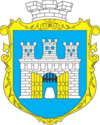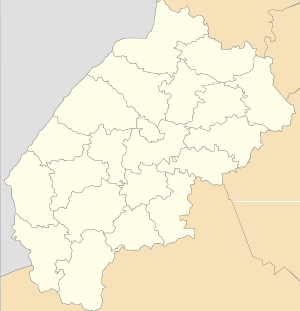Horodok, Lviv Oblast
Horodok (Ukrainian: Городо́к, Polish: Gródek) is a city in Lviv Oblast (region) of Ukraine. It is the administrative center of Horodok Raion. Population: 15,959 (2013 est.)[1].
Horodok Городок | |
|---|---|
City | |
 Flag  Coat of arms | |
 Horodok Location in Ukraine | |
| Coordinates: 49°47′00″N 23°38′40″E | |
| Country | Ukraine |
| Region | Lviv Oblast |
| District | Horodok Raion |
| Area | |
| • Total | 30 km2 (10 sq mi) |
| Population (2001) | |
| • Total | 15,825 |
| • Density | 530/km2 (1,400/sq mi) |
| Time zone | UTC+02:00 (EET) |
| • Summer (DST) | UTC+03:00 (EEST) |
| Postal code | 81500 |
| Area codes | +380 3231 |
| Website | місто Городок (Ukrainian) |
History
Horodok was first mentioned by Nestor the Chronicler in the Primary Chronicle. The Galician–Volhynian Chronicle mentions that the King Daniel of Galicia came to Horodok with his forces to join Mstislav Mstislavich the Bold while they fought with Polish-Hungarians over the Galician land.
In the mid-14th century, together with whole Kingdom of Rus, the settlement was annexed by the Kingdom of Poland. Its name was changed to Gródek, and it remained in Poland for the next 400 years. In 1372, King Jagiello founded here a Roman Catholic parish. During this reign, Gródek also received Magdeburg rights. This was the place where King of Poland and Grand Duke of Lithuania Jagiello died on 1 June 1434.
Until the Partitions of Poland, Gródek was part of Ruthenian Voivodeship. A battle between Ukrainian Cossack and Polish forces took place here in 1655 (see Battle of Horodok (1655)), in which Ukrainian Cossack Bohdan Khmelnytsky defeated Polish forces and than laid siege to Lviv.
In 1772, Gródek was annexed by the Habsburg Empire, as part of Austrian Galicia, where it remained until late 1918. German-speaking settlers established their own colony, called Vorderberg (1788). Austrian authorities closed local Franciscan monastery, turning it into a military depot. In 1903, a monument to Wladyslaw Jagiello was unveiled here, and in 1906, the name of the town was changed from Gródek to Gródek Jagielloński, in honour of the king. During World War I, Horodok was twice the location of fierce battles: In the Battle of Gródek (1914), the advancing Russian army captured the town from Austria-Hungary, and a year later, a combined German and Austro-Hungarian force fought the Russians in the Battle of Gródek (1915).
In the Second Polish Republic, Gródek was the seat of a county in Lwow Voivodeship. The town had three Roman Catholic churches, one Greek-Catholic, and a synagogue. It also was a military garrison, where a unit of Polish Army’s 5th Infantry Division was stationed. According to the 1921 census, Poles made 72% of the population, Ukrainians 26%, and Jews 2%.
During the Invasion of Poland, Gródek was captured by the Wehrmacht on 13 September 1939, and later taken over by the Red Army. It was then recaptured by the Germans in 1941. At this time, the Jewish population of Gródek was approximately 5,000 people[2], or 800 families[3]. During the summer of 1942, approximately half of the Jews in Gródek were murdered by the Nazis[3]. The remainder were shot and buried in mass graves on 3 February 1943 in the final liquidation of the Jewish ghetto in the town.[2][3]
From 1945–1991, Gródek was a part of the Soviet Union, and returned to its historical name of Horodok (Городок). Since 1991 it has been part of Ukraine.
Churches and Monasteries
Gallery
.jpg) Earthy fortifications from the times of the Galician principality XI-XIII centuries.
Earthy fortifications from the times of the Galician principality XI-XIII centuries.- Holy Transfiguration Monastery, XV - XX centuries.
- Wooden church of St. John the Baptist, built in 1755[4]
- Church of the Annunciation, built in 1633
- Church of the Holy Spirit
- Church of St. Nicholas, built in 1510
- A memorial to the victims of political repressions and the Exaltation of the Holy Cross Church.
- St. Volodymyr & Olga Church in Horodok
Religious Buildings in Horodok, Lviv Oblast
| number | The name | description | address | file | |
|---|---|---|---|---|---|
| Horodok | Administrative center of the Horodok Raion in Lviv Oblast (province) of Ukraine |  | |||
| 001 | Church of the Annunciation of the Blessed Virgin Mary (Stone).[5] | Church of the Annunciation of the Blessed Virgin Mary 1633 (Stone). Horodok, Lviv Oblast. (Architectural memo in the city Horodok) | st. Kotsyubynskogo, 5 | ||
| 002 | St. John the Baptist Church[6] | Church of St. John the Baptist 1754 (wood). Horodok, Lviv Oblast.((Architectural memo in the city Horodok)) | st. Stusa, 12 | ||
| 003 | Roman Catholic Church the Exaltation of the Holy Cross.[7] | Roman Catholic Church the Exaltation of the Holy Cross. Church (the Gothic part) was built at the expense of King Wladyslaw Jagiello.((Architectural memo in the city Horodok)) | Lvivska Street, 4 | ||
| 004 | Church of the Transfiguration in Horodok.[8] | Church of the Transfiguration in Horodok, 15th century (the former Franciscan monastery). | st. Park, 3 | ||
| 005 | Church of the Holy Spirit.[9] | Church of the Holy Spirit, which was built on the site of the Roman Catholic chapel of St. Barbara. | Lvivska Street, 79 | ||
| 006 | Church of St. Nicholas with a bell tower (1510).[10] | Church of St. Nicholas with a bell tower (1510). Built on the site of a wooden church of St. Nicholas of Myra. | Street. St. Nicholas | ||
| 007 | St. Volodymyr & Olga Church. | St. Volodymyr & Olga Church. Horodok (Dovzhanka), Lviv Oblast. | Horodok (Dovzhanka) | ||
| 008 | The Church of the Beheading of St. John the Baptist | The Church of the Beheading of St. John the Baptist Horodok, Cherlyany faubourg | Horodok(Cherlyany faubourg) |
People from Horodok
- Petro Vergun – Ukrainian Greek Catholic priest, Blessed Hieromartyr
- Stepan Bilak – Ukrainian politician, envoy to the Polish Sejm in the 1920s and 1930s
- Franciszek Duszenko – Polish sculptor, rector of Academy of Fine Arts in Gdańsk
- Tadeusz Kaniowski – Polish radiologist and physician
- Jan Pawel Lenga – Roman Catholic bishop
- Roman Lysko – Ukrainian Greek Catholic priest and martyr
- Ross Martin – American actor, emigrated to the United States as an infant
- Les Martovych (1871–1916),[11] Ukrainian writer, lawyer, and community activist from 1899 to 1903
- Jerzy Sawicki – Polish legal expert and law professor
- Hipolit Sliwinski – Polish architect and politician, envoy to the Sejm
- Igor Gorin - American baritone, emigrated to the United States as a teenager
Notes
- Чисельність наявного населення України [Actual population of Ukraine] (in Ukrainian). State Statistics Service of Ukraine. Retrieved 21 January 2015.
- kehilalinks.jewishgen.org https://kehilalinks.jewishgen.org/Gorodok/index.html. Retrieved 2020-05-11. Missing or empty
|title=(help) - "Gorodok, Ukraine (Pages 30 - 67)". www.jewishgen.org. Retrieved 2020-05-11.
- Українська Церковна Архітектура, Церква св. Іоана Хрестителя 1754 рік(in Ukrainian)
- Церква Благовіщення УГКЦ (XIV ст.).(in Ukrainian)
- Городок. Св. Івана Хрестителя 1754(in Ukrainian)
- Костел Воздвиження Чесного Хреста.(in Ukrainian)
- ГОРОДОЦЬКИЙ ДЕКАНАТ, Храм Преображення Господнього(in Ukrainian)
- Церква Святого Духа(in Ukrainian)
- Церква Св.Миколая (in Ukrainian)
- Martovych, Les
External links
| Wikimedia Commons has media related to Horodok, Lviv Oblast. |